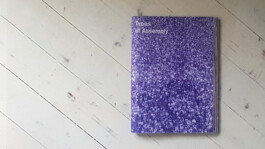
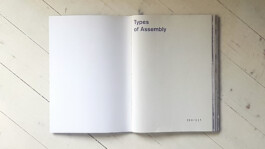
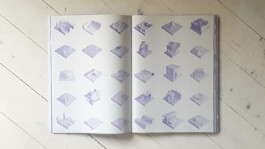
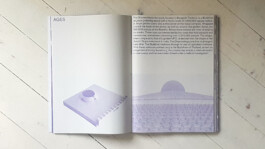
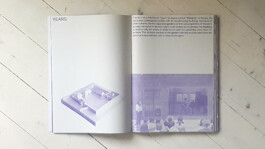
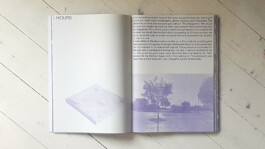
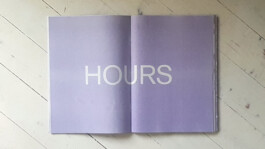
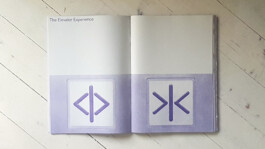
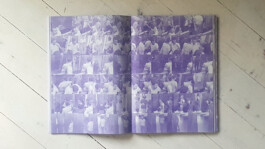
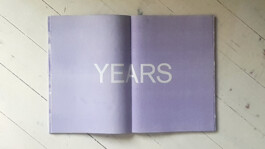
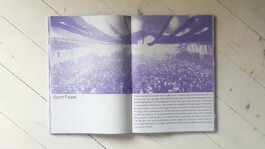
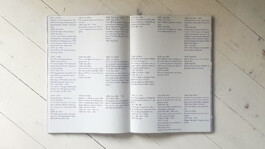
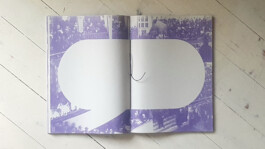
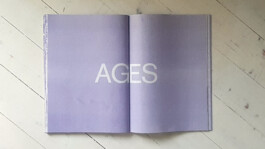
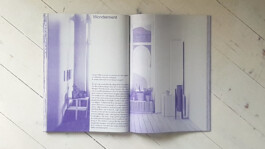
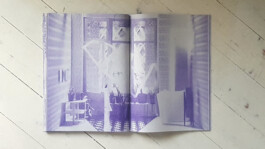
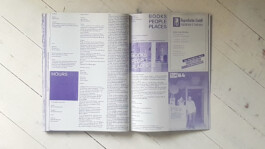
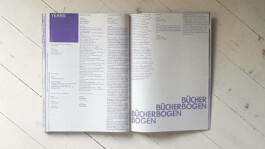
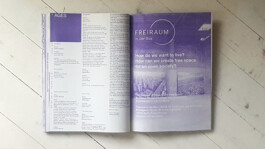
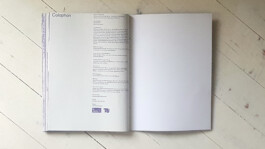
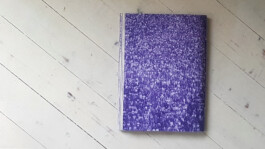
Pre-pandemic, I, along with a group of students, worked on producing a magazine on architectural discourse for the FG Hehl seminar TYPES of Assembly. We conceptualized, designed, contributed articles, and self-published 200 copies of the magazine. Copies are still available at Roundabout, situated in the foyer of the architecture faculty at the Technisches Universitaet, Berlin ;)
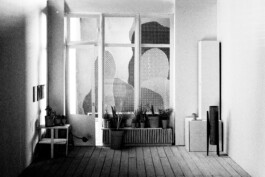

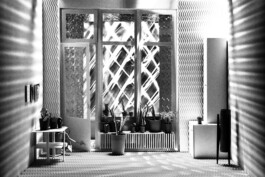


Wonderment
I would like to plant a question in the reader's mind before this article begins.
At what point does water become wet?
It might not seem directly relatable to the content. For the author it is just one of the distinctions of thought that allows for detachment, like a mantra a counter-response to our environment at any moment of the day; wonderment is again experienced.
The small round table slightly offset from the corner of the room displays a variety of well-composed items that individually invoke a culture and-or religion. Collectively they represent a clichéd notion of eclectic iconography that has ridden the meme roller coaster for over sixty years. spanning the Baby Boomers to Gen Z.
The light is soft since the sources can be traced to a tall floor lamp, and a small salt crystal resting atop the second small table in the room, sharing the surface with an Aztec patterned planter full of mother-in-law’s tongue. The smell of incense fills the room to its edges and escapes through the window covered by a curtain of non-descript origin evoking mandalas overlooking the……………….....
The image described, by now is quite familiar as far as our collective cultural awareness has established. The room is far from unique and could be placed in all manner of situations. From the set of a boho fashion shoot, reprising 60’s counterculture to a palliative care unit administering psychoactive medicine to patients with terminal diseases.
The room itself is a vessel that contains a history that precedes this specific treatment. Mental health care became more humane in the 19th century. An understanding was developed that patients being treated in soft homely furnishings, rather than shackled and incarcerated as criminals began to establish the characterisation of the tradition of recumbent speech. Laying prone on the analyst’s couch castes our thought to Freudian psychoanalysis, however, the roots can be traced further back to ancient Greece where guests would recline to discuss philosophy and drink wine at the symposion[i].
Back to the 20th century and the gathering of minds. Poets, artists, and surrealism theorists were laying groundwork. Electrified by Sigmund Freud’s newly published theories of the unconscious[ii], a precedent for the deeper exploration of consciousness and understanding the self.
Reaching maturity of self-awareness, we develop a consistent image of our surroundings and therefore our own presence, since we are the interpretant that observes the image. Contradictorily, we do not consider self as image, we like to relate or understand body beyond a mere materialist physicality, yet we deny the same abstraction to our surroundings. This is understood in Zen Buddhism as the first layer of ego or plainly Māyā.
One learns visual cues, this is part of growing up, or rather one trains our body to operate within the built environment.
This is a conservation technique employed by the brain to save energy. An important necessity, the world that the collective ‘we’ have constructed over hundreds of thousands of years requires a constant knowledge of adapted conventions, for instance, it is very helpful to know how to look through a rectangular window, understanding that the nature sways from the wind while there is a glass surface preventing the breeze on one’s face.
The aggregate of knowledge that assembly of ages has offered allows an instant response to a projectile rolling towards us or a flat wooden surface to balance objects, necessary for consumption, nutrition, or reclining. For us they resemble our every day; of course, I talk about automobiles, tables of food and sofas, the mundane every day. What would one think if there could be ways to re-experience the notion of firstness again, unlearn convention. Would this be re-wonderment?
What was consumed is irrelevant, the action also. What interests us for this article is how can we allow the conventions to melt away from our understanding, shake the collective social norms from our minds and allow ourselves to be lost in novelty, because it is possible……...........................................
As consumer, symbols drip away, symbols of the new morph into each other, and material trappings slump, losing their grip along with one’s ego.
Begin with the description of a room, any room a little bland, maybe. A moment arrives, or rather blends; time is dissolved. The grip of understanding gives way to wonderment, this feeling lost to the vague history of one’s childhood, unconstrained from assumption.
Move towards a historical trip, maybe we have experienced this before? María Sabina, the name should be noted and further researched – Aldous Huxley’s correspondence with Humphry Osmond that led to the word psychedelic[iii]. Al Hubbard and Tim Leary’s future application models of psychedelics to revolutionise society from the top to the underground[iv], visionary. Not forgetting the high priest of the “heroic dose”[v] Terence McKenna.
The room is still very much part of the history and present – sliding back into the seat as the question of illusion is suggested, the angle of the question is not clear. Patterns of the (d)rug display alternatives to one’s visual narrative/dogma. Is it possible to retain information of the experience? The question becomes irrelevant again as you dive back into one’s shadow, possibly looking from behind. Ătman welcomes you to the sound of one hand clapping.
Visual acuity shifts – holographic principles display themselves to a field, does this suppose that an alignment of an alternative narrative is coming?
What is our potential – how does this remind one of our possibilities?
Once we were child, our ambition had no boundaries.
Conflict is not sustainable and the experience that one endures seeks to direct ones understanding that nature is cooperation.
Empirical data becomes untangled into a subjective thread – in ten more minutes even the subjective yarn of reality will break.
The whip of conciseness splits the air with an intense crack.
Air separating the previous positions back into order, feelings of bliss fall back under the command of the absurd every day, measured, calculated, reposed.
One can make many assumptions, the fact however remains available only to the beholder. The adult games we play daily maintain a sense of status quo. The difficulty is the valuation system that is placed on our general perceptions, also, illusionary. The system is enchantment. With hypnotic suggestion we follow the thread hoping to assemble a coherent past for our friends and family to recollect, we hope. At least that used to be the modus operandi. The conveniences of the modern have taken care of that now; providing you have enough space in the cloud.
For the social beast, the rules we have learned are sacrosanct. This game of life has been played on each generation going back into time unrelatable to us, rendering traceable roots to the illusionary unrecognisable. One must understand that we are also active participants at this creative point, what potentiality might this evoke cannot be comprehended until the action is undertaken. Granted in the current state of civil parlay, a large portion of normality is at stake. I suggest the gamble is worth the risk, stripping bare one’s ego, allowing the room to unfold into itself can become an assembly of wonderment.
Alan Watts once posed the question to a crowd, “do you beat your heart or don’t you?”[vi]
Once more, at what point does water become wet?
[i] Nathan Kravis, On the Couch
A Repressed History of the Analytic Couch from Plato to Freud (MIT Press, 2017), 12.
[ii]Jane Alison, The Surreal House (Yale University Press, 2010)
[iii]Aldous Huxley and Humphry Osmond, Psychedelic Prophets: The Letters of Aldous Huxley and Humphry Osmond (McGill-Queen's University Press, 2018)
[iv]Dr Timothy Leary, The Politics of Ecstasy (Paladin, 1970)
[v]Terence McKenna, True Hallucinations (Harper One, 1994)
[vi]Alan Watts, Out of Your Mind, The Web of Life Lecture (Sounds True, 2015)





















Pre-pandemic, I, along with a group of students, worked on producing a magazine on architectural discourse for the FG Hehl seminar TYPES of Assembly. We conceptualized, designed, contributed articles, and self-published 200 copies of the magazine. Copies are still available at Roundabout, situated in the foyer of the architecture faculty at the Technisches Universitaet, Berlin ;)





Wonderment
I would like to plant a question in the reader's mind before this article begins.
At what point does water become wet?
It might not seem directly relatable to the content. For the author it is just one of the distinctions of thought that allows for detachment, like a mantra a counter-response to our environment at any moment of the day; wonderment is again experienced.
The small round table slightly offset from the corner of the room displays a variety of well-composed items that individually invoke a culture and-or religion. Collectively they represent a clichéd notion of eclectic iconography that has ridden the meme roller coaster for over sixty years. spanning the Baby Boomers to Gen Z.
The light is soft since the sources can be traced to a tall floor lamp, and a small salt crystal resting atop the second small table in the room, sharing the surface with an Aztec patterned planter full of mother-in-law’s tongue. The smell of incense fills the room to its edges and escapes through the window covered by a curtain of non-descript origin evoking mandalas overlooking the……………….....
The image described, by now is quite familiar as far as our collective cultural awareness has established. The room is far from unique and could be placed in all manner of situations. From the set of a boho fashion shoot, reprising 60’s counterculture to a palliative care unit administering psychoactive medicine to patients with terminal diseases.
The room itself is a vessel that contains a history that precedes this specific treatment. Mental health care became more humane in the 19th century. An understanding was developed that patients being treated in soft homely furnishings, rather than shackled and incarcerated as criminals began to establish the characterisation of the tradition of recumbent speech. Laying prone on the analyst’s couch castes our thought to Freudian psychoanalysis, however, the roots can be traced further back to ancient Greece where guests would recline to discuss philosophy and drink wine at the symposion[i].
Back to the 20th century and the gathering of minds. Poets, artists, and surrealism theorists were laying groundwork. Electrified by Sigmund Freud’s newly published theories of the unconscious[ii], a precedent for the deeper exploration of consciousness and understanding the self.
Reaching maturity of self-awareness, we develop a consistent image of our surroundings and therefore our own presence, since we are the interpretant that observes the image. Contradictorily, we do not consider self as image, we like to relate or understand body beyond a mere materialist physicality, yet we deny the same abstraction to our surroundings. This is understood in Zen Buddhism as the first layer of ego or plainly Māyā.
One learns visual cues, this is part of growing up, or rather one trains our body to operate within the built environment.
This is a conservation technique employed by the brain to save energy. An important necessity, the world that the collective ‘we’ have constructed over hundreds of thousands of years requires a constant knowledge of adapted conventions, for instance, it is very helpful to know how to look through a rectangular window, understanding that the nature sways from the wind while there is a glass surface preventing the breeze on one’s face.
The aggregate of knowledge that assembly of ages has offered allows an instant response to a projectile rolling towards us or a flat wooden surface to balance objects, necessary for consumption, nutrition, or reclining. For us they resemble our every day; of course, I talk about automobiles, tables of food and sofas, the mundane every day. What would one think if there could be ways to re-experience the notion of firstness again, unlearn convention. Would this be re-wonderment?
What was consumed is irrelevant, the action also. What interests us for this article is how can we allow the conventions to melt away from our understanding, shake the collective social norms from our minds and allow ourselves to be lost in novelty, because it is possible……...........................................
As consumer, symbols drip away, symbols of the new morph into each other, and material trappings slump, losing their grip along with one’s ego.
Begin with the description of a room, any room a little bland, maybe. A moment arrives, or rather blends; time is dissolved. The grip of understanding gives way to wonderment, this feeling lost to the vague history of one’s childhood, unconstrained from assumption.
Move towards a historical trip, maybe we have experienced this before? María Sabina, the name should be noted and further researched – Aldous Huxley’s correspondence with Humphry Osmond that led to the word psychedelic[iii]. Al Hubbard and Tim Leary’s future application models of psychedelics to revolutionise society from the top to the underground[iv], visionary. Not forgetting the high priest of the “heroic dose”[v] Terence McKenna.
The room is still very much part of the history and present – sliding back into the seat as the question of illusion is suggested, the angle of the question is not clear. Patterns of the (d)rug display alternatives to one’s visual narrative/dogma. Is it possible to retain information of the experience? The question becomes irrelevant again as you dive back into one’s shadow, possibly looking from behind. Ătman welcomes you to the sound of one hand clapping.
Visual acuity shifts – holographic principles display themselves to a field, does this suppose that an alignment of an alternative narrative is coming?
What is our potential – how does this remind one of our possibilities?
Once we were child, our ambition had no boundaries.
Conflict is not sustainable and the experience that one endures seeks to direct ones understanding that nature is cooperation.
Empirical data becomes untangled into a subjective thread – in ten more minutes even the subjective yarn of reality will break.
The whip of conciseness splits the air with an intense crack.
Air separating the previous positions back into order, feelings of bliss fall back under the command of the absurd every day, measured, calculated, reposed.
One can make many assumptions, the fact however remains available only to the beholder. The adult games we play daily maintain a sense of status quo. The difficulty is the valuation system that is placed on our general perceptions, also, illusionary. The system is enchantment. With hypnotic suggestion we follow the thread hoping to assemble a coherent past for our friends and family to recollect, we hope. At least that used to be the modus operandi. The conveniences of the modern have taken care of that now; providing you have enough space in the cloud.
For the social beast, the rules we have learned are sacrosanct. This game of life has been played on each generation going back into time unrelatable to us, rendering traceable roots to the illusionary unrecognisable. One must understand that we are also active participants at this creative point, what potentiality might this evoke cannot be comprehended until the action is undertaken. Granted in the current state of civil parlay, a large portion of normality is at stake. I suggest the gamble is worth the risk, stripping bare one’s ego, allowing the room to unfold into itself can become an assembly of wonderment.
Alan Watts once posed the question to a crowd, “do you beat your heart or don’t you?”[vi]
Once more, at what point does water become wet?
[i] Nathan Kravis, On the Couch
A Repressed History of the Analytic Couch from Plato to Freud (MIT Press, 2017), 12.
[ii]Jane Alison, The Surreal House (Yale University Press, 2010)
[iii]Aldous Huxley and Humphry Osmond, Psychedelic Prophets: The Letters of Aldous Huxley and Humphry Osmond (McGill-Queen's University Press, 2018)
[iv]Dr Timothy Leary, The Politics of Ecstasy (Paladin, 1970)
[v]Terence McKenna, True Hallucinations (Harper One, 1994)
[vi]Alan Watts, Out of Your Mind, The Web of Life Lecture (Sounds True, 2015)